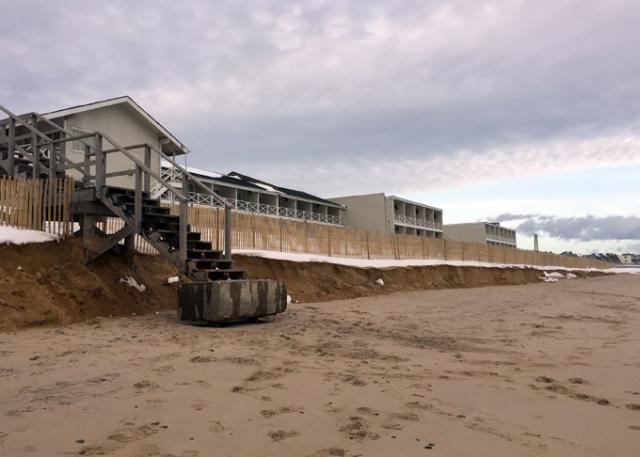U.S. Senator Calls Montauk ‘Dirtbag Beach’ a Boondoggle

A 3,100-foot-long sandbag sea wall installed last year by the Army Corps of Engineers on the downtown Montauk beach is included in the latest edition of “Wastebook,” an annual survey of “government pork and boondoggles” by Senator Jeff Flake of Arizona. Environmental activists here were critical of the seawall from the start and it has now, through erosion of sand seaward of it, narrowed the beach at times to a wet, impassable strip.“Dirtbag Beach,” as it is called in Mr. Flake’s report, is among projects he identifies as having frittered away federal dollars that could be better spent on “true national priorities,” such as infrastructure repair and critical health research.“We can do more without spending more by simply making better sense out of how we spend every cent,” Mr. Flake writes in the introduction.This year’s version, with a comic book-illustrated cover blaring “Senator Jeff Flake Presents: Wastebook PORKémon Go,” lists 50 projects the lawmaker considers a waste of federal money and an example of “upside down spending priorities.” Montauk’s “Dirtbag Beach” is number 17.“Wastebook PORKémon Go” provides an index of just some of the questionable expenses lurking throughout the federal budget that collectively cost taxpayers more than $5 billion,” the report alleges.“Just like the monsters in the Pokémon Go game that took America by storm this past year, government boondoggles come in all shapes and sizes and pop up just about everywhere.”The $8.4-million Montauk installation is listed in the “Wastebook” table of contents along with other projects and their dollar amounts, including a “High- Speed Train Going Nowhere Fast” ($3.1 billion); a “Giant Glow-in-the-Dark Doobie” ($35,000), a 28-foot-tall billboard against driving while high; a $1.7 million “Hologram Comedy Club Laughing All the Way to the Bank,” at which resurrected dead comedians are brought back through technology to do their shtick; a $460,000 project in which “Computers Try to Learn Human Behavior by Binge Watching ‘Desperate Housewives’ ” and other shows, and a $3.4 million “Hamster Cage Match” using Syrian hamsters in a study of aggression and anxiety.A four-page entry details the history, status, and local responses to the Montauk Army Corps project, and includes photos, including an aerial of protestors who tried to stop the installation.“Is an unwanted government project the end of the world for the beach in Montauk, New York, the self-described ‘end of the world?’ ” the “Wastebook” asks in the entry. “The once pristine beach, known for its natural landscape and lack of development in the tiny hamlet at the tip of Long Island is now being derided as dirtbag beach.”“The U.S. Corps of Engineers plowed away the beach’s natural dunes and constructed a wall made up of 14,000 1.7-ton geotextile bags holding orange non-beach sand topped with three feet of whiter beach sand. The sandbag wall stretches along more than a half-mile of shoreline and is surrounded by fences. The beach is now only accessible via four narrow, elevated walkways,” the Wastebook states.“The unsightly barrier, however, has residents and visitors ‘wondering if the town has destroyed the shore in order to save it.’ ” Local coverage in The Star proved “an invaluable resource” for examination of the issue,” according to Roland Foster, a senior policy advisor for Senator Flake.Meanwhile, contractors for the Army Corps have come and gone but the project is still not ready to be declared finished and handed over to the town, which, along with Suffolk County, is to be responsible for ongoing maintenance, town officials said this week.According to Alex Walter, an assistant to Supervisor Larry Cantwell, the contractors last visited early last month to make some fixes after storms damaged sandbags and wiped out fencing around the buried seawall. New fencing was installed and beach grass replanted, he said, and an outflow pipe on the beach near Lowenstein Court was repositioned after it was found to have been installed in a way that caused water to undermine the footings of one of the new wooden stairways leading over the seawall onto the beach.More work is also expected to be done at the South Edison Street vehicle access to the beach, where interlocking hollowed concrete blocks were laid to create a “drainage mat.” Specifications called for the blocks to be buried, filled with stones, and covered with sand, Mr. Walter said at a town board meeting on Tuesday. But the sand put on top of them was quickly washed away, and they remain exposed.Further causing dismay, Mr. Walter reported that a 50-foot-long protective sand berm installed seaward of the buried sandbag wall has also washed away and not been replaced. The beach now drops to a lower level right along the piled sandbags, with a gap at the bottom of exposed wooden stairs.The berm is mentioned in a State Department of Environmental Conservation document that outlines the maintenance responsibilities that are to fall to the town, but “we don’t want to be responsible for maintaining a berm that doesn’t exist,” Mr. Cantwell said Tuesday. The Army Corps had proposed doing a final walk-through during the first two weeks of this month, he said, before turning over maintenance responsibility, but has not been in touch. The estimated costs of maintenance remain uncertain given the effects of recent tidal action.
